
How can I tell if my dog's heatstroke is serious
Let’s be real: It’s a sticky August morning in Los Angeles, and you took your 2-year-old Golden Retriever, Max, for a walk a little later than usual
Watching your Samoyed puppy tumble around the living room, it’s hard not to wonder when that fluffy ball of energy will stop growing. Unlike some breeds that seem to hit their full size overnight, Samoyeds have a unique growth timeline that requires patience and understanding. By learning what to expect, you can ensure your furry friend develops into a healthy, happy adult.
Samoyeds typically reach their full height between 12 to 18 months. During this period, male Samoyeds usually stand 21 to 23.5 inches (53-60 cm) at the shoulder, while females average 19 to 21 inches (48-53 cm). But height is just one piece of the puzzle. These Arctic dogs continue filling out and building muscle mass until they’re around 2 years old. It’s common to see a Samoyed look lanky and awkward as a teenager, only to transform into a sturdy, well-proportioned adult later on.
The growth process isn’t linear. You’ll likely notice spurts of rapid growth followed by plateaus. Some weeks, your Samoyed might seem to outgrow their collar overnight, while other months pass with minimal change. It’s important to remember that every dog is unique. Genetics, diet, and exercise all play a role in determining the exact age your Samoyed reaches maturity. If you’re concerned about your dog’s growth rate, consult your vet—they can use X-rays to check bone development and provide personalized advice.
 Proper nutrition is crucial during this growth period. Samoyed puppies need a diet rich in high-quality protein to support muscle development and calcium for strong bones. But overfeeding can lead to joint problems down the line. In many regions, pet owners are legally required to follow feeding guidelines based on their dog’s age and size. Always check the label of your dog food carefully and consider consulting a vet for a feeding schedule. As your Samoyed approaches adulthood, gradually transition them to an adult formula to avoid excess weight gain.
Proper nutrition is crucial during this growth period. Samoyed puppies need a diet rich in high-quality protein to support muscle development and calcium for strong bones. But overfeeding can lead to joint problems down the line. In many regions, pet owners are legally required to follow feeding guidelines based on their dog’s age and size. Always check the label of your dog food carefully and consider consulting a vet for a feeding schedule. As your Samoyed approaches adulthood, gradually transition them to an adult formula to avoid excess weight gain.
Exercise also plays a vital role in a Samoyed’s development. While puppies have boundless energy, it’s important not to overdo it. High-impact activities like long runs or jumping can strain growing joints. Short, frequent play sessions and gentle walks are ideal for puppies. Once your Samoyed reaches adulthood, you can gradually increase the intensity of their exercise routine. Remember, a well-exercised Samoyed is a happy Samoyed, but always respect your dog’s limits and local leash laws.
In addition to physical growth, Samoyeds also go through significant mental development. Between 6 months and 2 years, they enter the “adolescent” phase, which can be challenging for owners. This is when your usually obedient puppy might start testing boundaries. Consistent training and positive reinforcement are key during this time. Many areas have regulations about dog behavior in public spaces, so investing in training helps ensure your Samoyed is a well-behaved member of the community.
As your Samoyed approaches adulthood, you’ll notice subtle changes. Their playful puppy antics might give way to a calmer demeanor, but don’t worry—they’ll still have plenty of energy for fun. By understanding their growth timeline and providing the right care, you’ll watch your Samoyed transform from a clumsy puppy into a majestic adult. Cherish every stage of their development, because before you know it, you’ll have a loyal companion by your side for years to come.

Let’s be real: It’s a sticky August morning in Los Angeles, and you took your 2-year-old Golden Retriever, Max, for a walk a little later than usual

You're enjoying a summer afternoon at the park when you notice your dog has stopped panting and appears disoriented - their gums are bright red

Let’s paint the picture: You’re in your Denver apartment, watching your 4-year-old Boston Terrier, Ruby, plop down mid-play session with her favorite toy

Many dog owners notice their pets nails seem shorter after regular walks,but how much does this daily activity actually help?The answer depends on where you walk—concrete sidewalks or asphalt streets gently file nails as a dog's paws hit the ground

Most dog owners notice their pup scooting across the carpet at some point, but few connect it to impacted anal glands. These small sacs near a dog’s rectum secrete a scent for marking territory

Most vets agree that regular dog teeth cleaning is key to avoiding painful dental issues later. For healthy adult dogs, a professional cleaning at the vet’s office every 12 to 18 months usually works well.